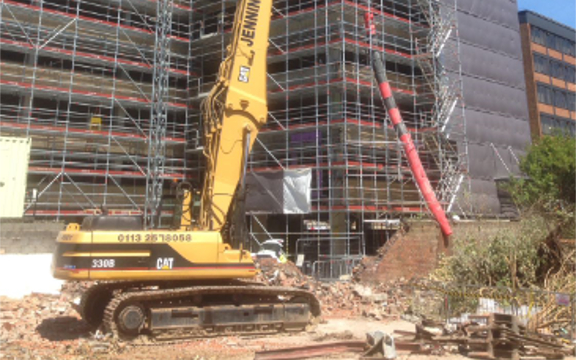
05 Jan Large Scale Building Demolition Explained
Demolition experts like Jennings must look at several factors when deciding how to conduct a large-scale demolition. Among other issues, we consider the location of the building, and its proximity to other structures, the building’s primary construction materials, the purpose of the demolition and how we’ll dispose of the debris.
By looking carefully at the factors surrounding a demolition, we can choose the strategy most likely to protect the surrounding area. This is why each project begins with an initial risk assessment and method statement.
Planning and Method Statements
Ahead of each project, a method statement and risk analysis ensure that the demolition crew can protect both their employees and the needs of the client. The documentation provided before the demolition includes:
- Details of required Asbestos removal
- Superstructure demolition details (for the foundations and floor slab)
- Soft strip removals of fixtures and fittings
- Consideration of surrounding elements that may affect the demolition
The specific requests of the client will also be considered. Some projects may require the preservation of particular aspects of the building. For instance, foundations may be kept in place for a new structure to be built directly after demolition.
Large Scale Buildings and Explosive Demolitions
Often, larger structures require more dramatic demolition techniques. Explosive or implosive methods are used with the help of certified and specialist contractors to remove parts of the weakening structure. When we’re sure that the site is safe following the explosion, we can return to clear the location of any remaining debris.
Crucially, for an explosive demolition to be successful, we will always make sure that we have a full set of structural blueprints available that we can use to identify the most critical aspects of the building, and where components need to be broken down. The plans also make it easier to determine which kinds of explosives to use.
Alternative Demolition Options for Large Scale Structures
The most popular alternative to an explosive demolition for larger structures is a high-reach arm. This is a good solution for buildings that are more than 66 feet high, and it often involves a base machine, such as an excavator that has been equipped with a long demolition arm. Demolition tools such as shears, a “crusher” or a hammer will be attached to the end of the arm to break apart small pieces of the building from the top down.
Using a high reach arm can be a safer alternative to explosive demolition. By removing large pieces of the structure in parts, we can ensure that there are fewer risks with pieces of falling debris.
Another option that’s well-known among many people considering demolition is the wrecking ball, or “crane and ball” demolition process. Though this is one of the oldest and most traditional forms of building demolition, it’s still a highly effective option. Typically used for masonry and concrete structures, wrecking balls can weigh as much as 13,500 pounds. The balls are suspended from a secure cable on a crane, and either dropped or swung carefully into the structure.
As with most forms of demolition, a wrecking ball project must always be performed by highly experienced and skilled crane operators. To eliminate any potential danger to the surrounding environment, it’s crucial to control the smoothness of the swing for the ball. Additionally, missing a target could mean that the crane tips or is overloaded. Unfortunately, wrecking ball demolition can cause a lot of dust and noise.
Selective Demolition Options
Finally, there are alternative methods of destruction available for projects that require structures to be only partially demolished. Selective demolition is popular today because it permits builders to recycle and reuse crucial building materials. Selective destruction of metals, brick, wood, and concrete means that a property being re-built may not need to start from scratch with new materials.
Selective demolition can be a very cost-effective option for large-scale structures, but the process is very labor intensive and can take a lot longer than a standard explosion or high-arm demolition.
Every project has its unique challenges to consider. The best way to proceed with any demolition project is to speak to the experts about your options. Contact Jennings today to discuss your demolition strategy.


No Comments